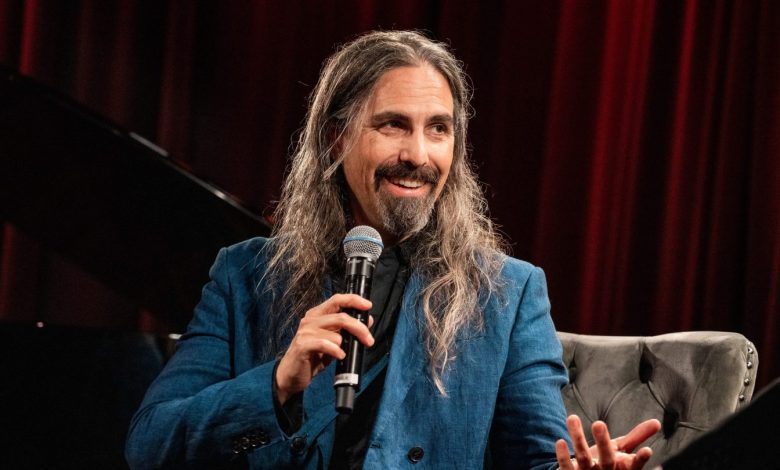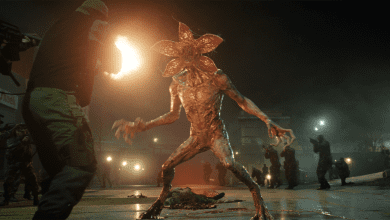Composer Bear McCreary Waited Over 20 Years to Finish This Song

In May of 2024, I found myself backstage with a dozen of my favorite musicians, including Slash, at the Fonda Theatre in Los Angeles, about to perform my debut rock concept album The Singularity for the first time. As the walls of the basement green room shuddered with the thunderous bass pulses of our opening act, Slash mentioned he’d recently returned from Vancouver, having visited the set of a film he was producing. “What’s the film?” I asked casually, lacing up my sneakers.
“We got the rights to remake this old movie from the ’80s. Deathstalker.”
I froze. Vivid memories of countless nights spent watching bad cult movies with my childhood friends flooded my mind, accompanied by the energetic drum machine pulses and synthesizer melodies of famed B-movie composer Chuck Cirino’s score for Deathstalker II. I spoke sooner than I could think. “Slash, we should make a theme song for your film using the original music from Deathstalker II!” Slash stared back at me with a look of surprise, then smiled.
I developed a love for cult movies in high school. Growing up, my friends and I would trek to the local video store every Friday and walk out with armloads of VHS cassettes, and later DVDs. All a film needed to catch our eye was bold cover art, and an entertaining premise—the promise of ninety minutes of sheer joy.
Some of the classic cult films were the first projects of filmmakers who would go on to become industry leaders: Sam Raimi’s The Evil Dead, Peter Jackson’s Dead Alive, Trey Parker’s Cannibal! The Musical, Joe Dante’s Piranha, and its sequel, James Cameron’s Piranha II: The Spawning and Danny Elman’s first score, Forbidden Zone.
But then there was the other stuff! Pure cult gold like Flash Gordon, The Adventures of Buckaroo Banzai Across the 8th Dimension, American Cyborg: Steel Warrior, Robot Jox, Highlander II: The Quickening, Fortress, Moron Movies, and anything put out by Troma, such as Sgt. Kabukiman N.Y.P.D. The sword and sorcery genre was always reliable for delightful low-budget cheese, with entries such as The Beastmaster, The Barbarians, and of course, the Deathstalker series. (I continue to love cult films to this day: witness my recent appearance on Red Letter Media’s cult film review show, Best of the Worst.)

Bear McCreary in his dorm room.
Courtesy Bear McCreary
One balmy summer night in the Pacific Northwest, around the time I was nineteen years old, my friends and I rented all four Deathstalker films to marathon in one sitting. We were inspired by their outrageous VHS cover art that promised epic tales of heroic barbarians rescuing buxom babes from giant monsters. Like most low-budget productions of that era, the Deathstalker films failed to live up to the promise of their Frank Frazetta-inspired box-cover art. However, Deathstalker II stood out, with its joyously comedic, self-aware tone. The score to Deathstalker II, composed by Chuck Cirino, was so instantly catchy that I picked up a little Casio keyboard and began to play along as it recurred throughout the film. (Never before, or since, have I played along with a film’s score during my first viewing!) Despite Chuck’s score being performed entirely on synthesizers, I felt in it a yearning to be expressed by a live symphonic orchestra.
When I went back to college in Los Angeles that fall, I produced my own orchestral arrangement of the theme, envisioning it as a huge cinematic spectacle. Given my technical limitations and lack of experience, my version ironically sounded even cheesier and more synth driven than Chuck’s original. I burned a CD of the music and put it on my literal and metaphorical shelf of abandoned ideas. But, in my heart, I still wanted to hear it performed by a real orchestra!
A few years later, when my first Battlestar Galactica soundtrack album was released, I was invited to take part in a composer signing at the iconic horror-themed bookstore Dark Delicacies. When I saw the guest list of nearly a dozen established industry veterans, one name stood out above the rest: Chuck Cirino. The synth-horn melody of Deathstalker II instantly blasted into my mind! A few days later, at the end of the afternoon, I sheepishly placed in Chuck’s hands a CD of my version of his Deathstalker music. He was surprised, perhaps even confused, that this young composer was so familiar with his score! That afternoon, I was finally able to answer the question that had been gnawing at me for years: Who, exactly, is Chuck Cirino and how did he create such a memorable score for this low budget B movie?
Chuck Cirino came of age in the swingin’, groovy ’60s, captivated as a child by the hip beats of Neal Hefti’s Batman theme, the sweeping grandeur of John Barry’s Born Free, and the dramatic, jangling riffs of the spaghetti western scores of Ennio Morricone, Bruno Nicolai and Carlo Rustichelli. Chuck’s father was a jazz musician in Miami Beach, playing in nightclubs, so Chuck grew up emulating him on organ, piano, trombone, and any other instrument he could get his hands on. As a young adult, he made his way to Southern California, where he befriended an aspiring filmmaker named Jim Wynorski.
“Years before Deathstalker, years before Jim was directing, we had a little group of guys that used to go to the Culver Theater in Culver City when it was a cheesy multiplex with six screens,” Chuck recalled recently. “We would bring a bottle of booze for the projectionist, and he would let us in through the side door. We would go every Friday night for a few years, and we would catch six wonderful B movies. Now, this was way before VHS, so this was the only place you could see these really raunchy movies. And a lot of them were sword and sorcery movies from Europe. We got a huge download of sword and sorcery and all kinds of weird stuff.”
Chuck found work in the film industry directing many cult-classic commercials, like “Fred R. Rated for Federated” for radio host and television personality Shadoe Stevens. His friend Jim Wynorski began working for legendary film producer Roger Corman. After Jim established his cinematic voice with his breakout cult hit, Chopping Mall, Corman assigned him the director’s chair on the sequel to Deathstalker, Corman’s shameless Conan the Barbarian homage.
One day, in 1986, Jim called Chuck and said he needed a score for his new film, Deathstalker II. They had previously worked together on Jim’s successful Chopping Mall. But, this time, their workflow would be different, because he hadn’t even shot the film. “There was no movie yet!” Chuck recalled with a laugh. All Jim told him was, “‘I need a cue that sounds like this. I need a cue that sounds like that. Give me a main theme and then give me six different versions of it.’ That’s all he said. It was like a grocery list!”
Chuck and Jim loved the sounds of spaghetti westerns, an influence instantly recognizable in the war-cry screaming sound that permeates his score. “I had the Prophet 2000,” a cutting-edge sampling keyboard. “Sampling was brand-new at the time. I could experiment with my voice in that. That’s actually me screaming into a microphone, going ‘aaaaaaah!!’ But I also had a sound effect from a hawk. I mixed the two together to create that sound. Whenever I hit the key, there it was for me.”
Working with other contemporary hardware, such as the Yamaha DX7, the LinnDrum, and the Italian Siel synthesizer, Chuck wrote music for Deathstalker II during his off-hours from directing commercials. “I was working all night. And coming back the next morning and working all day. These were the days when you’re young and your body can take it. I was literally editing during the afternoon, shooting in the morning, and scoring at night,” he said.
On his fifth day working on the score, he got an urgent call from Jim: “He called me up and said, ‘Chuck, you’ve got to have the master tape ready now!’” Just a few hours later, Jim picked up the tapes from Chuck. He was frantically trying to reach the airport in time to board a flight for Argentina, where the film would be shot and mixed.
After only five intense nights, Deathstalker was out of Chuck’s life seemingly as fast as it had entered it. Until it wasn’t.
The film was released a year later and quickly gathered a cult following. Chuck was surprised to realize that the music he had written over those five exhausting nights was resonating with audiences around the world. “It feels like it was the most important thing I did in my career,” Chuck said, with gratitude. “I wrote a theme that, maybe it’s not up there with the classic themes that I loved as a kid, but it’s appreciated. And I appreciate that. I feel super lucky that this has happened for me.”
More than thirty years later, even after Chuck scored nearly a hundred films (including the campy classics Chopping Mall, Ghoulies IV, and the DC Comics adaptation The Return of Swamp Thing), fans still single out his music for Deathstalker II.
In 2024, one of those fans was in the green room of the Fonda Theatre and said to Slash, “We should make a theme song for your film using the original music from Deathstalker II!”
“I saw Deathstalker II when it first came out, while I was working at Tower Video in Hollywood,” Slash recalled. “I thought it was really fun, and particularly loved that theme song. It was super anthemic. Then I went back and watched the first film and loved it (although it didn’t have the great theme song, it was still a really fun film). I used to put them both on the video monitors during my 4 p.m.-to-midnight shift. Fast forward to present day, my producing partners and I were given a new script of a Deathstalker reboot, and it was really good. I felt like it was something we should pursue making. And I really wanted to remake the Deathstalker II theme song. It was a total surprise to me that you knew the theme song, because the film is pretty obscure. But not only did you know it, you loved it, and knew it note for note. And you knew Chuck Cirino! This cemented in my mind what a powerful piece of music that theme really is.”
The week following the launch concert for my rock album The Singularity—an album I had worked on for half a decade—my brain and body were exhausted. However, I was energized by the prospect of reimagining Chuck Cirino’s music with Slash for his new film. I went into my studio and got to work. My first step was to reorchestrate Chuck’s music into the fully symphonic rendition I had always hoped to hear. Unlike in my early twenties working in my dorm room, in my mid-forties I finally had the skills and technology necessary to realize what I had always wanted to hear with this theme. I applied everything I’d learned scoring epic projects like God of War and The Lord of the Rings: The Rings of Power to “Deathstalker.” I imagined searing French horns blasting the melody from their upper register, while evocative strings and full choir sustained rich choral support.
I was not satisfied this time around to simply reorchestrate the theme, however. I wanted to transform it into something else: a true theme song, complete with lyrics. I wrote bass, guitar, and drum parts, imagining the same musicians from my rock record playing them. I recruited my brother, Brendan McCreary, co-producer and co-songwriter for The Singularity, to write lyrics and provide a powerful vocal performance.
“I love his voice, the quality of it,” Chuck said. “The attitude is just perfect for this song. And his voice has got this epic feeling already. Brendan did a fantastic job!”
While Brendan focused on lyrics, we collectively hammered on the driving hard-rock riffs to provide an intense motor to the music.
“The bridge riff just came to me from listening to the theme melody,” Slash recalled. “It was completely spontaneous. It took literally a minute to play it on my acoustic and send it over to you. I love when that happens.”
After just a few days messing with the material, I sent a demo to Slash and Brendan combining all our ideas. Right away, we all could hear how Chuck’s theme from Deathstalker II might be reborn as a rock anthem. “The first demo was actually pretty epic unto itself,” Slash said. “That’s when I knew we had something.”
The demo contained symphonic orchestra, blistering rock band, and a heartfelt lyric. There was only one problem: I was struggling to recreate the 1980s synth magic found in Chuck’s original recordings. Time to go to the source. I called up Chuck and told him about our project, asking for his help recreating the sounds from his original score.
Chuck recalled our first conversation about the project: “When you came to me and said you were going to do this with a full orchestra, it was hard to believe. I have never had an orchestra on my scores. Beyond that, it was really hard to believe because this has really not happened before. I don’t know of any story like this, where a composer could take part in one of their scores being reborn in a new way decades after writing it.” I asked him about his response to my first demo of the song: “I cried.”
Chuck enthusiastically agreed to help us write and produce our new theme song. He dug through the archives and recreated as much of his old synth work as he could, now with his contemporary hardware. Fortunately, he still had digital audio files lying around of the score’s iconic screaming, hawk-and-human-voice war-cry samples. When he sent me those clips, I felt I had unearthed a holy relic of 1980s soundtracks! Chuck’s authentic synth layers were the missing piece that made the puzzle complete. Finally, our song, “Deathstalker,” was ready to be recorded!
On September 19 and 20, 2024, we recorded live symphony orchestra on “Deathstalker” in Eastern Europe. I listened from my studio in Los Angeles, and felt chills run down my spine hearing a room full of nearly one hundred musicians performing Chuck’s melody. I was finally hearing the tune the way I had always imagined it should be heard. I was hearing Deathstalker II performed by live orchestral musicians for the first time in film history! I was giddy with excitement, thinking about sharing these recordings with Slash, Brendan, and Chuck the following day.
A day later, I stepped into the fabled Henson recording studio on La Brea in Los Angeles with my hurdy-gurdy under my arm. Slash walked in a few minutes later, and we set up to make music.
Chuck had arrived before me, and introduced himself to everybody in the band, as well as our talented recording engineer Ben Sedano. This marked the first time Chuck was meeting all the other musicians involved beyond me.
“You walk in and you see this group of people all working around one piece of music that you wrote so long ago; it’s just an amazing feeling,” Chuck recalled. “There’s nothing like it. It was a career peak for me. I’ve never been able to score a huge film. … Us ‘B-Movie Guys’ don’t get that stuff!”
Throughout our creative process, Slash shared snippets of the film with me. I was excited to see director Steven Kostanski’s take on the material, because he has proven himself a master of practical effects. And yet, nothing could prepare me for the emotion I felt when I saw the finished film. The film’s imagery, cast, tone, and music were everything I had hoped for. Composer duo Blitz//Berlin crafted a pulse-pounding musical underscore. Hearing our song in the credits gave me chills!
“What you’ve done with Deathstalker II is mind-blowingly epic,” Chuck said, gratefully. “But, what it became, and how you did it, became the big message to me: that you love this music.”
I am grateful to Slash for letting me be part of his new version of Deathstalker. Creating this song with him, Brendan, Chuck, and so many of my favorite musicians gave me the opportunity I had been waiting over twenty years for, to reimagine Chuck Cirino’s Deathstalker II theme. My journey with this song started on that balmy summer evening when I was nineteen, during our movie marathon, as I picked up a little Casio keyboard and played along with the film. With any luck, some nineteen-year-old kid out there somewhere will watch this new movie, hear our music, and start their own journey.
On Saturday, McCreary will publish an expanded version of this blog post at www.BearMcCreary.com.
HiCelebNews online magazine publishes interesting content every day in the movies section of the entertainment category. Follow us to read the latest news.





